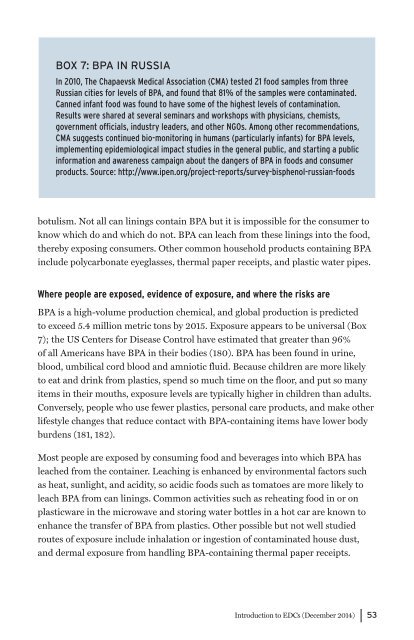Introduction to Endocrine Disrupting Chemicals
Introduction to Endocrine Disrupting Chemicals
Introduction to Endocrine Disrupting Chemicals
You also want an ePaper? Increase the reach of your titles
YUMPU automatically turns print PDFs into web optimized ePapers that Google loves.
BOX 7: BPA IN RUSSIA<br />
In 2010, The Chapaevsk Medical Association (CMA) tested 21 food samples from three<br />
Russian cities for levels of BPA, and found that 81% of the samples were contaminated.<br />
Canned infant food was found <strong>to</strong> have some of the highest levels of contamination.<br />
Results were shared at several seminars and workshops with physicians, chemists,<br />
government officials, industry leaders, and other NGOs. Among other recommendations,<br />
CMA suggests continued bio-moni<strong>to</strong>ring in humans (particularly infants) for BPA levels,<br />
implementing epidemiological impact studies in the general public, and starting a public<br />
information and awareness campaign about the dangers of BPA in foods and consumer<br />
products. Source: http://www.ipen.org/project-reports/survey-bisphenol-russian-foods<br />
botulism. Not all can linings contain BPA but it is impossible for the consumer <strong>to</strong><br />
know which do and which do not. BPA can leach from these linings in<strong>to</strong> the food,<br />
thereby exposing consumers. Other common household products containing BPA<br />
include polycarbonate eyeglasses, thermal paper receipts, and plastic water pipes.<br />
Where people are exposed, evidence of exposure, and where the risks are<br />
BPA is a high-volume production chemical, and global production is predicted<br />
<strong>to</strong> exceed 5.4 million metric <strong>to</strong>ns by 2015. Exposure appears <strong>to</strong> be universal (Box<br />
7); the US Centers for Disease Control have estimated that greater than 96%<br />
of all Americans have BPA in their bodies (180). BPA has been found in urine,<br />
blood, umbilical cord blood and amniotic fluid. Because children are more likely<br />
<strong>to</strong> eat and drink from plastics, spend so much time on the floor, and put so many<br />
items in their mouths, exposure levels are typically higher in children than adults.<br />
Conversely, people who use fewer plastics, personal care products, and make other<br />
lifestyle changes that reduce contact with BPA-containing items have lower body<br />
burdens (181, 182).<br />
Most people are exposed by consuming food and beverages in<strong>to</strong> which BPA has<br />
leached from the container. Leaching is enhanced by environmental fac<strong>to</strong>rs such<br />
as heat, sunlight, and acidity, so acidic foods such as <strong>to</strong>ma<strong>to</strong>es are more likely <strong>to</strong><br />
leach BPA from can linings. Common activities such as reheating food in or on<br />
plasticware in the microwave and s<strong>to</strong>ring water bottles in a hot car are known <strong>to</strong><br />
enhance the transfer of BPA from plastics. Other possible but not well studied<br />
routes of exposure include inhalation or ingestion of contaminated house dust,<br />
and dermal exposure from handling BPA-containing thermal paper receipts.<br />
<strong>Introduction</strong> <strong>to</strong> EDCs (December 2014) 53















